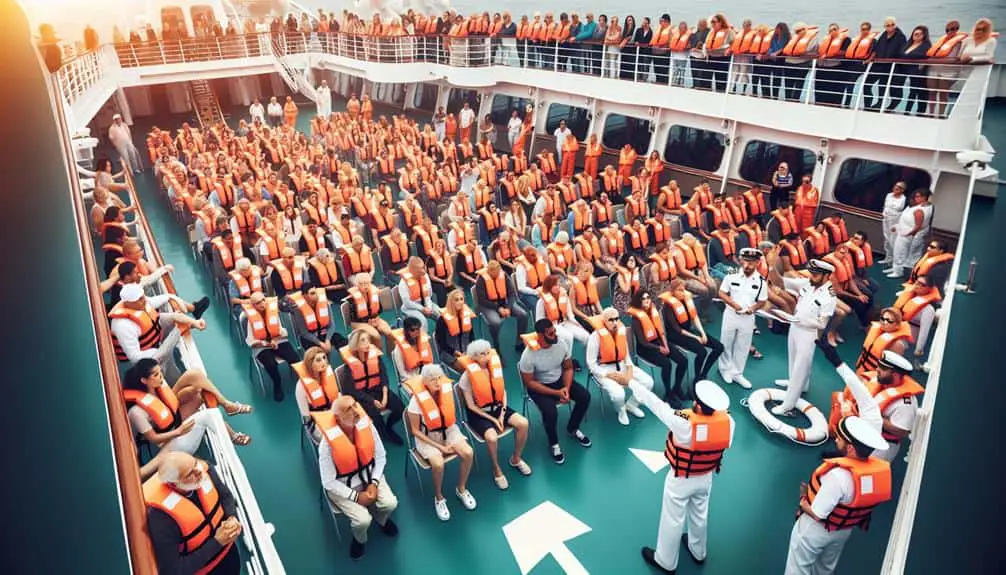When cruising, your safety duties on cruise ships include attending safety briefings, engaging in emergency drills, reporting hazards, following crew instructions, and knowing safety procedures for swift response. Prioritize safety by focusing during briefings, obeying crew commands, and familiarizing with emergency exits. Actively participate in drills, listen to instructions, and don't hesitate to ask questions. Be vigilant for hazards and swiftly report any risks to crew members. Your actions contribute to a secure environment onboard.
Key Points
- Pay attention during safety briefings and demonstrations.
- Participate actively in emergency drills and follow crew instructions.
- Report safety hazards promptly to the ship's crew.
- Follow crew instructions, ask for clarification if needed.
- Be aware of safety procedures, evacuation routes, and assembly points.
Cruise Ship Safety Briefings
When boarding a cruise ship, passengers are required to attend mandatory safety briefings to familiarize themselves with emergency procedures. Safety demonstration etiquette is vital during these briefings. It's essential to pay close attention, refrain from talking, and follow instructions provided by the crew. Additionally, respecting the seriousness of the safety briefing guarantees that everyone on board is prepared for any potential emergencies that may arise.
Passenger responsibilities during drills include actively participating in the safety demonstration, locating and donning life jackets as instructed, identifying the nearest emergency exits, and familiarizing oneself with the designated assembly station. It's imperative to take these responsibilities seriously as they directly impact the overall safety of all passengers and crew members on the cruise ship.
Emergency Drill Participation
During emergency drills on cruise ships, passengers must actively engage in safety procedures to guarantee preparedness for potential emergencies. The emergency response training is essential for ensuring the safety and well-being of all individuals on board. Passengers should attentively listen to crew instructions, participate in life jacket and emergency equipment demonstrations, and familiarize themselves with the nearest emergency exits. Following safety protocol during these drills is paramount to effectively managing any crisis situation that may arise while at sea.
In the event of an actual emergency, the knowledge and skills gained during these drills can make a significant difference in the outcome. Passengers are required to take these drills seriously, as they're designed to prepare everyone for various scenarios such as fires, collisions, or evacuations. Understanding the safety protocol and being able to act swiftly and confidently can help prevent panic and ensure a more organized response to emergencies. By actively participating in emergency drills, passengers contribute to creating a safer environment for themselves and others on board.
Reporting Safety Hazards
To ensure the safety of all passengers and crew members on board, promptly report any safety hazards encountered during your time on the cruise ship. Hazard identification is vital in maintaining a secure environment. Be vigilant in recognizing potential risks such as slippery floors, malfunctioning equipment, or obstructed emergency exits. Safety reporting is the first step in addressing these hazards effectively.
Upon identifying a potential hazard, engage in a quick risk assessment. Evaluate the seriousness of the situation and the likelihood of harm. Consider factors such as the number of people at risk and the proximity to emergency resources. Swift action is essential in minimizing risks and preventing accidents. Report the identified hazard to the ship's crew immediately for incident response.
Understanding the importance of hazard identification, safety reporting, risk assessment, and incident response is fundamental in upholding a safe cruise ship environment for all passengers and crew members. Your proactive approach can contribute significantly to the overall safety protocols onboard.
Following Crew Instructions
Upon encountering any instructions given by the crew members, promptly follow their guidance to guarantee the safety and smooth operation of the cruise ship. Effective crew communication is essential for ensuring the safety of all passengers on board. To adhere to safety protocol, here are key points to take into account:
- Listen Attentively: Pay close attention to instructions provided by the crew members through announcements or direct communication.
- Ask for Clarification: If you don't understand any instruction, seek clarification from the crew to ensure you fully comprehend what's required.
- Act Swiftly: In case of emergencies or safety drills, act promptly and follow the crew's directions without delay.
- Respect Authority: Follow the chain of command and respect the authority of the crew members who are trained to handle various situations onboard.
Awareness of Safety Procedures
Ensuring your awareness of safety procedures on a cruise ship is essential for your well-being and the security of all passengers. Safety protocols are in place to guide you on what to do in case of emergencies. Familiarize yourself with the location of life jackets, emergency exits, and muster stations. It's your passenger responsibility to participate in safety drills and pay attention to safety briefings conducted at the beginning of the cruise.
During the safety drill, listen carefully to the crew's instructions and ask questions if anything is unclear. Understand the different alarm signals and what actions they require. Follow crew directions promptly in case of an emergency. Take note of evacuation routes and assembly points. Knowing these safety procedures not only protects you but also assists the crew in efficiently managing any crisis that may arise. By being proactive and informed, you contribute to a safer environment for yourself and your fellow passengers.
Frequently Asked Questions
Are There Age Restrictions for Participating in Emergency Drills on Cruise Ships?
When participating in emergency drills on cruise ships, age restrictions apply. It is essential to note that individuals must be of a certain age to partake in these vital safety exercises, enhancing preparedness for all passengers.
How Often Are Crew Members Trained in Safety Procedures on Cruise Ships?
Crew preparedness is paramount on cruise ships. Regular safety training guarantees swift response in emergencies. Passengers must participate in safety drills for their own well-being. Crew members are typically trained in safety procedures multiple times a year.
Can Passengers Bring Their Own Safety Equipment on Board, Such as Life Jackets or Smoke Hoods?
You can't bring your own safety equipment like life jackets on a cruise ship due to life jacket regulations. Smoke hoods are typically provided by the ship, and passengers must follow the smoke hood policies in place.
Are There Specific Protocols for Passengers With Disabilities During Emergency Situations on Cruise Ships?
In emergency situations on cruise ships, specific protocols exist to accommodate passengers with disabilities. These protocols address tailored evacuation procedures, communication methods, and assistance needs. Passenger age and participation in safety drills are vital aspects to take into account for effective emergency management.
What Measures Are in Place to Prevent Accidents or Injuries Caused by Rough Seas or Inclement Weather While on a Cruise Ship?
When on a cruise ship, your safety during rough seas or bad weather is guaranteed through strict weather protocols, ample safety equipment, and emergency procedures. Understand your passenger responsibilities and follow instructions to stay secure.




